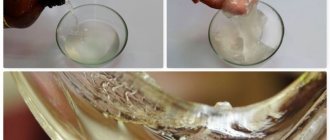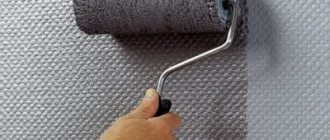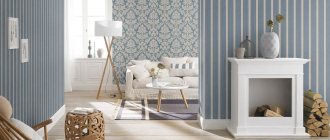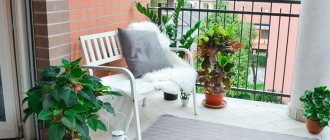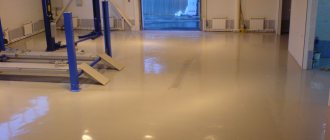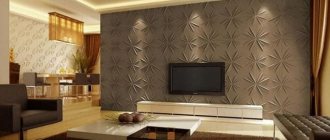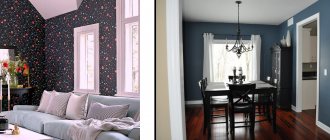Linoleum is considered one of the best, most affordable and popular types of flooring. Manufacturers make three types of them. These are commercial or technical coatings, semi-commercial and household linoleum. Each type has its own special technical characteristics and is designed for rooms with different levels of traffic. Thus, technical linoleums are intended for those rooms where a lot of people walk every day. Household is used only for installation in residential buildings and apartments. Between them there is also semi-commercial linoleum. Its characteristics are higher than those of household flooring - the flooring is resistant to wear. And it’s easier to install than commercial ones.
Device
These floor coverings consist of three layers. Each of them performs its own functions.
This is a special backing made of polyvinyl chloride - in semi-commercial versions of linoleum it can only be foamed. In some models, the backing is made using fiberglass. This ensures even greater strength and protects the coating from stretching. Fiberglass increases sound and heat insulation. Some brands like to highlight this backing as a separate layer.
Linoleum also consists of a decorative layer. He is fully responsible for the appearance of the material. The decorative layer can be monochromatic, multi-colored, or with imitation of various natural materials (for example, stone, granite, wood). A pattern is applied to the decorative layer.
So that the floor covering can withstand loads, the decorative one is also covered with a protective layer. It is a transparent polyvinyl chloride or polyurethane. The characteristics of semi-commercial linoleum are such that the thickness of the protective layer is from 0.4 to 0.6 millimeters.
Flooring in an apartment: what is the difference between commercial linoleum and household linoleum?
Flooring intended for living rooms is not as durable as its counterpart. However, this cannot be called a minus. After all, increased wear resistance is not required from a home floor, although with proper use it can last up to 15 years. Which, you see, is not so little.
Today, the choice of PVC materials for apartments is almost limitless: manufacturers offer models of various colors and textures. This makes it one of the most popular building materials. In addition, the relatively low cost also affects.
Photo: Tarkett
Photo: Tarkett
Photo: Tarkett
- Floor
What do you need to know when choosing PVC linoleum?
In addition to the external component, when purchasing a household coating, you should also take into account such a parameter as the thickness of the working layer. It is this that protects the drawing and all the material from being erased. The larger it is, the longer it will last. The maximum thickness for this type is 0.35 mm.
In a room with low traffic, for example, in a bedroom, you can take a material with a smaller protective layer, while in a corridor or kitchen - with a larger one.
Often, a natural material is chosen for apartments - marmoleum, made using linseed oil. Like its PVC counterparts, this floor is durable, and, in addition, has antibacterial properties and hypoallergenic characteristics.
Photo: Forbo
Photo: Forbo
Photo: Forbo
However, it also has disadvantages:
- Price. Eco-material is more expensive than synthetics.
- Strength. Quite fragile and non-elastic material.
- Non-moisture resistant. Cannot be placed in the bathroom.
- Decoration Materials
How to choose and where to buy eco-friendly finishing materials
Technical features
The main feature of this flooring is its weight. One meter of ordinary household linoleum weighs on average 1.8 kilograms. And the weight of semi-commercial is 2.5 kilograms. The width of the rolls can vary from 2 to 4 meters. At the same time, in appearance the structure is no different from household analogues. But there are some peculiarities. Let's see what they are.
There is a backing here. It also exists in household coatings. The substrate is necessary to create a strong and elastic base. Due to it, the characteristics of heat and sound insulation are increased. High-quality linoleum also has a reinforcing layer made of fiberglass. This has already been noted above. Reinforcement makes it possible to stabilize the linear dimensions of the material, as well as enhance the strength characteristics. The manufacturer's warranty is 7-12 years.
Wear resistance classes of linoleum
The classification of linoleum regarding wear resistance classes is practically no different from the classification of laminate or parquet boards. According to accepted standards, there are 10 classes that divide all products on the market into 3 groups:
- For residential premises - classes 21-23, characterized by different levels of intensity of use. They are used for installation in residential areas of a private house (bedroom, living room, hallway).
- For service and office premises - classes 31-34, the degree of intensity of their use increases from class to class. Experts recommend installing such products in offices, public places, schools, airports, shops, etc.
- For industrial premises – classes 41-43. Used in repair, warehouse, and production facilities.
Semi-commercial linoleum comes in four classes:
- 32 – used in offices with low traffic levels;
- 33 – offices with average traffic;
- 34 – office premises with high traffic;
- 41 – production premises that do not have a high degree of traffic.
Pros and cons of coverage
Like any type of flooring, this type also has advantages and disadvantages. Among the main advantages are high wear resistance, heat resistance, good sound insulation qualities, affordable prices, ease of installation and maintenance. Office linoleum of this type is an excellent choice.
The only drawback is very minor: the coating is made entirely on a synthetic basis. Not everyone will like this - today there are lovers of natural, environmentally friendly materials.
Advantages and disadvantages
Semi-commercial coating has the following advantages:
- high strength and wear resistance;
- good insulation qualities;
- ability to absorb sound;
- low cost of the synthetic version;
- easy installation process;
- low maintenance requirements.
The only disadvantages include the unnaturalness of the coating. If you choose linoleum from natural components, the disadvantage is the high price, comparable to other natural materials - wood, cork, stone.
Felt-based linoleum
What it is? Felt-based linoleum is another type of semi-commercial flooring. Let's see what this material yielded.
By using felt as a base for linoleum, it was possible to get rid of many disadvantages. Thus, it is known that the coating is characterized by significant residual deformation - felt helped to significantly reduce it due to its elasticity, softness and layered structure. The rigidity has also decreased - now felt-based linoleum has excellent springiness even on a concrete screed.
With the use of felt, it was possible to improve the sound insulation characteristics. There is an opinion that such linoleum can be dangerous. But actually it is not. Felt is impregnated in production with special non-flammable liquids - the risk of fire is minimized.
There are two types of these coatings: the first consists of five layers, the second - of seven. Each layer has its own task. Which linoleum is better? You need to choose based on the type of room.
The outer layer is a transparent polymer that reflects all negative influences. The second one performs protective functions - its thickness is 0.7 millimeters. The task of the third layer is aesthetics. The fourth is a layer of felt. The fifth is a dense layer of polyvinyl chloride.
Seven-layer linoleum is slightly different. So, the top layer is made of polyacrylic or PVC. The second one is also made of PVC. It enhances the protective characteristics of semi-commercial linoleum. GOSTs oblige manufacturers to make this layer with a thickness of 0.15 to 0.8 millimeters. The third layer is decorative. The fourth is a foamed PVC backing, the fifth is fiberglass. Next comes the felt backing. And the last layer is necessary to provide additional waterproofing.
Main characteristics of semi-commercial linoleum
To understand the characteristics of this material, it makes sense to first consider the main parameters of linoleum, so to speak, “in a short numerical format” and then talk in more detail about some of them.
A summary average table of the main characteristics of semi-commercial linoleum can be presented something like this:
| Name of parameters | Indicators |
| Wear resistance class | 31, 32, 33, 34 |
| Abrasion group, g/m² | from 10 to 15 (“P”) |
| Types by structural structure | homogeneous and heterogeneous |
| The basis of heterogeneous semi-commercial linoleum | felt or foamed polyvinyl chloride (PVC) |
| Thickness of the protective layer, mm | 0,35 ÷ 0,6 |
| Total thickness of the floor covering, mm | 2,2 ÷ 4,5 |
| Length of material per roll, m | 20 ÷ 30 |
| Roll width, m | 5,0; 4,5; 4,0; 3,5; 3,0; 2,5; 2,0; 1,5 |
| Specific gravity of the material, kg/m² | 2÷5 |
| Flammability, group | G3 - G4 |
| Flammability, group | B2 - B3 |
| Smoke generation degree | D3 |
| Flame Spread | RP1 - RP2 |
| Permanent deformation, mm | ≤ 0,17 — ≤ 1,33 |
How is semi-commercial linoleum classified based on overall wear resistance?
Semi-commercial linoleum, like any other, is divided into classes according to wear resistance. For this semi-commercial category of floor coverings, the first digit in the class numbering is “three”:
| Class of semi-commercial linoleum and its graphic designation - pictogram | Load level on the floor surface | Load intensity | Recommended locations for use in public buildings and residential buildings. |
| 31 | Short | Premises with minimal movement of people. | Non-reception offices, conference rooms, storage rooms, document storage rooms, hardware rooms, hotel rooms. In a residential building or apartment - a bedroom, a storage room, an office. |
| 32 | Average | Average intensity of people traffic. | Offices, reception areas, employee offices. At home - living room, children's room, dining room. |
| 33 | High | High intensity of human traffic | Large offices, shops, academic classrooms, bars, etc. In a residential building - suitable for the hallway, corridor, kitchen, home gym. |
| 34 | Very tall | Significantly high intensity of movement of people or goods | Large stores, warehouses, halls of medical organizations, waiting rooms, passage corridors, foyers of cultural institutions, etc. In a residential building or apartment, the use will be completely redundant, and the potential for wear resistance will remain unclaimed. |
Abrasion of linoleum
As a rule, a material showing a higher level of resistance to abrasion loads has a higher cost. And to evaluate this durability, a special classification has been introduced, dividing linoleums into four groups. The assessment is carried out using specially developed laboratory methods, with loads dosed in intensity and time. In this case, homogeneous linoleum is assessed by the total loss of mass (volume), and heterogeneous - by the thinning of the upper protective layer.
From a consumer point of view, it is hardly necessary to know the magnitude of such losses. But you still need to know the order in which these electability groups are located.
- “T” is the most abrasion-resistant linoleum, which has a protective transparent layer of pure polyvinyl chloride. Most often, purely commercial flooring has this marking.
- “P” is a material showing a moderate level of abrasion of the protective layer or homogeneous coating. As a rule, the most popular varieties of semi-commercial linoleum in residential construction (classes 32 and 33) belong specifically to this group.
- “M” - low resistance to abrasive load. Such a coating among semi-commercial ones can only be in the general wear resistance class 31. For the scope of application, see the table above.
- “F” is a floor covering with very low abrasion resistance. In semi-commercial versions of such linoleum it cannot be unambiguous.
One more interesting nuance can be added. Assignment to one group or another (from the highest “T” to the lowest “F” rack) to a certain extent also indicates the resistance of the linoleum coating to dirt. A high-quality protective layer will not only help maintain the integrity and well-groomed condition of the floor, but also its color design in its original state , that is, not spoiled by “dirt inclusions” for many years.
The thickness of the protective layer of semi-commercial material cannot be less than 0.3÷0.6 mm, however, it must be remembered that the larger this parameter, the higher the price of the coating.
For example, a company widely known in Russia uses materials of its own design for the protective layer of its products:
- “EXTREME PROTECTION” - this protective coating can increase the strength of semi-commercial linoleum by six to seven times compared to its household counterpart;
- "TITANIUM" is an additional varnish layer that simplifies cleaning the floor covering from dirt.
A very original model of semi-commercial linoleum "Tarkett" - "Aston 3", with an unusual mosaic surface design and textured embossing.
In addition to protective compositions, it uses a special type of embossing - “TUREX”, which very reliably recreates the textured pattern of the surface of wood, stone or ceramic tiles as closely as possible to natural materials. However, when choosing a floor covering with embossing, you should remember that it requires more frequent and thorough maintenance than conventional material with a smooth surface. The explanation, as they say, literally “lies on the surface” - dirt can accumulate in the unevenness of the decorative microrelief.
The basis of semi-commercial linoleum
Semi-commercial heterogeneous linoleum may have a felt or polyvinyl chloride base. According to this characteristic, it is selected depending on the room in which it will be installed. For example, for rooms where increased humidity is possible, it is better to choose a PVC-based coating.
The top photo shows linoleum on a felt base, and the bottom photo shows foamed PVC as the basis for the top layers
The advantage of polyvinyl chloride-based material is that it is easier to join two sheets using cold welding. This does not require any special tools, which allows you to do the installation yourself. Linoleum joints are fused together using chemical technology. And if this process is carried out in full compliance with the requirements, the connecting seam will be both sealed and practically invisible.
Linoleum sizes
Linoleum coating can have different thicknesses. A material is considered thin if this parameter is one and a half millimeters or less. All products with greater thickness are classified as coatings of normal thickness. As a rule, semi-commercial linoleum with a thickness of less than 2 mm is quite rare - from this thickness you have to “dance” when choosing.
Linoleum can have different widths and lengths per roll
A fairly large range in terms of the width of linoleum rolls (from 1 to 5 meters in increments of 500 mm) allows you to decide whether the covering will be laid with one sheet, or whether several fragments will have to be joined together. Of course, the best option would be to choose a coating model whose width does not require docking. No matter how strong the welded seams are, the whole fabric is always more reliable in terms of tightness. And you shouldn’t forget about the aesthetic component either - the seams are unlikely to decorate the floor surface.
When choosing the width of the material and ordering the required length of the purchased fragment, you must remember that the dimensions should be specified with a margin. So that the linoleum is placed on the walls by 50 ÷ 70 mm - then it will be precisely cut in place to eliminate the possibility of errors due to the curvature of the wall.
Fire resistance of the material
All building materials belong to one of five flammability groups, which are designated by a letter: from “NG” (non-flammable) to “G4”.
- Linoleum, unfortunately, cannot boast in this regard - semi-commercial types are usually classified as “G3” or even “G4”.
- Not everything is fine with flammability (three groups designated by the letter “B”), only “B2” or even “B3”.
- The spread of the flame from the source of the linoleum fire will be quite moderate: “RP1” or “RP2” (with a maximum of “RP4”).
additional characteristics
On the back side of the linoleum sheet, manufacturers often place pictograms that carry a lot of additional information about the characteristics of the floor covering. Unfortunately, there is no standard here, and manufacturers often use their own “character sets”. But, as a rule, such icons are intuitive and do not raise any additional questions for most users.
An example of icons placed on the reverse side of the linoleum sheet
So, let's say, among the pictogram indicators the following may be found: the following icons:
- bed - the cover can be used for bedrooms;
- sofa - the material is well suited for living rooms;
- table and office chair - used for flooring in offices;
- children's toy - linoleum is safe for children's rooms;
- kitchen stove - use in the kitchen;
- faucet with a drop of water - the coating can be used in rooms with high humidity;
- office chair wheel - material resistance to roller wheels;
- zipper - linoleum has antistatic properties;
- sun - resistance to ultraviolet radiation, that is, to fading of the decorative layer;
- hammer - resistance to shock loads;
- a pipe that makes sounds - the soundproofing qualities of linoleum;
- cat or dog paw - resistance to pet claws;
- a curved tube and arrows going up from it - the material can be used for laying a “warm floor” system on top.
- sleeping cat is a material of increased comfort.
In addition to those mentioned, there are other icons. But, as you can see, from the pictures it’s easy to guess what exactly they mean.
Coating care
Even the most weather-resistant floor coverings require careful use and periodic maintenance. Semi-commercial linoleum will not require much effort to rid it of dust, dirt and various stains. To wet clean this floor covering, you will need a soap solution and relatively soft floor rags or mops with special soft attachments.
Wet cleaning of linoleum flooring
To avoid damaging the outer polyurethane layer of the material, do not use hard brushes or cleaning compounds containing abrasive substances.
Even if the specifications indicate that linoleum is resistant to pressure from the legs of heavy pieces of furniture, it is recommended to attach special elastic pads to them.
* * * * * * *
Are there any secrets for laying semi-commercial linoleum?
The technology for laying linoleum of this type has practically no significant differences. Flooring can be done either with glue or simply on a prepared surface. Read about the rules for laying linoleum with your own hands
Features of application
If you need to improve a room where the humidity level is high, then it is best to purchase a foam version. Felt cannot withstand moisture levels above 5 percent. It will begin to grow mold and rot.
Modern semi-commercial felt linoleums have disadvantages. Thus, there is a need to carefully prepare the foundation. Welding of the fabric should only be carried out by professionals. The resulting coating should be monolithic.
If it is not possible to lay the flooring without joints, then at the joints you should strive for maximum protection from moisture. The first felt products exhibited shrinkage. Now manufacturers have filled the market with special heterogeneous linoleum. He practically doesn't sit down.
Laying technology
The process of installing a semi-commercial coating is no different from laying household linoleum and can easily be done independently. Installation consists of the following steps:
Preparing the floor . The base must be brought into a perfectly even state, since all flaws will certainly appear on the finishing coat and reduce its service life. The old coating must be removed. If linoleum is laid on a wooden base, it should be covered with sheet material - plywood, chipboard or plasterboard.
Floor measurement. The surface area to be finished is measured, taking into account all architectural features. If the walls are uneven, you need to buy linoleum in excess, adding a few centimeters to each edge.
Material adjustment. Before fixing to the base, linoleum sheets are laid on the floor, the patterns on them are adjusted to each other. The material is cut using a long ruler and a regular sharp knife.
Joining and securing seams . To make the joints even, it is better to lay the coating overlapping and then evenly cut right through the joint. After this, the edges of the canvases are glued together using cold welding.
Linoleum in the kitchen
The Sintepros coating from Tarkett can withstand serious loads. Its installation is standard for semi-commercial coatings. Among the advantages are affordable prices. A square meter of linoleum will cost much less than tiles or other similar coatings. The material is heat-resistant and waterproof. Linoleum is durable and lasts a long time. The colors of linoleum allow it to be used in any interior.
The disadvantage is that the products are made only on a synthetic basis. If people who suffer from allergies live in the apartment, then it is better to choose something else. Also, sometimes the coating may require treatment with special mastics.
Well-known manufacturing companies of semi-commercial linoleum
The Russian market offers a large number of semi-commercial linoleum coverings made by different manufacturers. It is recommended to be very careful when choosing this material, since it can literally “poison the life” of a family, primarily due to its smell, as well as inconvenience in operation.
When choosing a specific product, it always makes sense to study reviews from customers who are already using this material.
Semi-commercial linoleum in the interior
So, from well-known manufacturing companies we can highlight:
- Tarkett is an international company with French and Serbian roots that produces various types of floor coverings, including a wide range of linoleum. To increase the resistance of floors to wear, the developers of this company use their own unique developments of external coatings.
One of the most famous flooring brands among Russian consumers
The manufacturer makes every effort to improve both the base and the protective layer of linoleum. However, it cannot be said that Tarkett products are an ideal material option. They, like most analogues from other manufacturers, have their own disadvantages.
- Gerflor is a French company that has been supplying its products to the market for several decades. Products are manufactured strictly in accordance with established European Union standards and undergo the most stringent control at the level of laboratory tests.
Not so well-known in our area, but a very high-quality product - coatings
Unfortunately, Gerflor coatings are not presented on the Russian market in the same wide range as Tarkett products. They certainly deserve the closest attention.
- "Grabo" is a Hungarian concern that produces high-quality floor coverings that contain fiberglass, which strengthens linoleum and extends its service life. The products are resistant to deformation, perfectly absorb noise, and also make floors warmer.
The linoleum of this Hungarian company also deserves good reviews
It uses calendered polyvinyl chloride as a base in its products.
- Juteks is a company from Slovenia that has been producing linoleum and other coatings for decades. During this period, she gained extensive experience in the manufacture of this product.
Logo of a famous
The manufacturer's developers are constantly working to improve their products, which are sold all over the world. Linoleum undergoes a special treatment, thanks to which it perfectly resists moisture, ultraviolet radiation, and is also easy to clean from dirt.
- Armstrong is a transnational company, the largest in the production of a wide variety of building materials, including linoleum.
There is no need to doubt the quality of the products of this, without exaggeration, “veteran” and “giant” in the field of construction materials production
The products of this famous brand are distinguished by their excellent durability, as well as the highest degree of heat and sound insulation that is possible for a floor covering.
The best linoleum on felt
When choosing which linoleum is better, you should focus on Tarkett products from the “Idyll Nova” collection. It is suitable for every room. The protective layer is 0.5 millimeters and is securely glued to the felt base. As for the total thickness, it is 3.5 millimeters. The manufacturer claims that this is the best choice for a children's room.
First of all, the coating is affordable. This linoleum is also soft and warm and has high heat and sound insulation characteristics. The colors of linoleum are modern and interesting. There are also disadvantages - this is not a very durable protective layer. The material does not like shocks; it cannot be installed in rooms with high humidity. Despite the presence of a protective layer, its service life is short.
Commercial linoleum: an option for office and industrial premises
The most wear-resistant and expensive, it is made of dense PVC, painted throughout the entire thickness of the layer, due to which the pattern is practically not erased. It is often compared to stone and tile, it is so durable.
Photo: Tarkett
Photo: Tarkett
In addition to wear resistance, the commercial type is fire and moisture resistant. This is no coincidence. It is used in places with so-called high intensity of use, in other words, with high traffic. These include various educational and medical institutions, cafes and restaurants, sports clubs and swimming pools, office premises and shops, vehicles and so on.
There are two types of commercial linoleum: heterogeneous and homogeneous.
Homogeneous coating
It has a homogeneous structure, its thickness ranges from 1.5 to 3 mm.
Photo: Forbo
Photo: Forbo
Photo: Tarkett
Peculiarities
- Due to the homogeneity of the composition, it is easy to restore after damage.
- Requires special care: the surface is polished and a protective mastic is applied.
- There is a limited choice of pattern textures: the most common is imitation marble or its analogue - speckled.
- But you can effectively combine different colors and even create floor paintings.
Heterogeneous coverage
This is a polyvinyl chloride (PVC) floor, which consists of several layers and is not only commercial, but also semi-commercial and domestic.
Photo: Tarkett
Photo: Forbo
Photo: Tarkett
It is based on fiberglass (it makes it stronger and does not allow it to stretch), a layer with a pattern and a protective coating. Manufacturers often modify the composition of products, thereby expanding their properties. Like, for example, in the diagram above.
Peculiarities
- Manufacturing companies are not limited in design, so there are samples with textures that imitate wood, stone, with various prints and patterns.
- The top coating allows you to give the material additional properties: for example, sound insulation, protection against static electricity, anti-slip effect.
- In most cases, it does not require special care. For cleaning, a soap solution is enough, rarely with the addition of special products.
- Heterogeneous commercial products are more expensive than homogeneous ones.
A little history of linoleum
The distant ancestor of modern rolled and tiled flooring can be considered oiled sheets of dense fabric, which were used not only for sails, but also for laying on the floor. In 1763, Englishman Nathan Smith patented a material that consisted of woven panels coated with a hot mixture of pine resin, brown dye, beeswax and linseed oil - camptulicon. The new flooring was not particularly popular among buyers, but the manufacturer continued to experiment and look for optimal combinations.
In 1843, natural rubber and ground cork were introduced into the composition of the future linoleum, but due to a serious increase in the price of ingredients (due to the invention of car tires), the composition was processed and modified linseed oil - drying oil - was introduced. The technology for producing the finished product was also improved, and on December 19, 1863, Frederick Walton received a patent for the production of linoleum (linum - flax and oleum - oil). In subsequent years, the recipe, as well as the manufacturing method, was refined. At the beginning of the 20th century (Great Britain) supplied the European market with a floor covering made from a mixture of several vegetable oils (modified) called glyphthalic linoleum. The same goods were also produced by factories of the Russian Empire located in Riga, Odessa and other cities.
Marmoleum.
Today this product is produced by the largest factories in the world - Forbo, Tarkett and others. In Europe, it retained its old name - natural linoleum. In our country it is known by the name of the registered trademark of the Forbo Flooring Systems company - marmoleum or marmoleum.
Table 1 . Advantages and disadvantages of marmoleum
| pros | Minuses |
| High wear resistance | Permanent characteristic odor of oils |
| Bacteriostatic | Brittleness at sub-zero temperatures |
| Non-slip surface | High price |
| Moderate fire resistance | The need for installation using special adhesives |
| Antistatic | |
| Disposal by biodegradation | |
| Easy cleaning and care | |
| Health safety for adults and children |
On the territory of our country since the mid-50s. last century, due to the scarcity of natural raw materials, a new product was developed - PVC linoleum. Although the composition of this floor covering had nothing in common with natural material, nevertheless, its name was retained.
PVC linoleum.
Table 2 . Features of PVC linoleum
| pros | Minuses |
| High wear resistance | In case of fire, releases toxic substances |
| Moisture resistance and water resistance of the surface | Accumulates static electricity and attracts dust |
| Acceptable prices | Most collections have a smooth, slippery surface |
| Easy styling | |
| Easy care | |
| Long service life under suitable operating conditions |
Synthetic linoleum is produced homogeneous (high-density with a uniform structure) and heterogeneous (multilayer).
The second type consists of:
- A base layer made of foamed polyvinyl chloride or polyester threads that form a non-woven felt fabric. The Tarket and Utex assortment includes collections on a duplicate basis;
- The front layer, which is a thin, high-density layer of PVC, onto the flat surface of which a decorative pattern is applied by printing in accordance with the designer’s idea: board, parquet, ceramics, abstraction and much more;
- A wear layer is a so-called transparency, a protective thin layer (usually polyurethane or complex with special additives) that protects the product from abrasion and other loads, as well as household chemicals, water, sunlight, etc.
Large factories add additional layers to the linoleum structure. This could be fiberglass for reinforcement, sealing layers for the backside that prevent water absorption, etc.
To summarize: now on sale you can find linoleum products manufactured in the following formats:
- Natural marmoleum in rolls, tiles and combi versions (HDF-based linoleum products);
- PVC linoleum, homogeneous and heterogeneous rolled, cut into strips or tiles;
- A synthetic special material used exclusively for difficult operating conditions (railway or sea transport, industrial premises, etc.). These are relin, colloxylin or nitrocellulose linoleum and others.
In domestic conditions, as well as for retail, commercial and public facilities, the first two types are used. But where and what exactly – read below.
Colors
For commercial linoleum there are a large number of possible color design options.
The main factors that will determine the color of the coating are practicality, uniqueness of the design and color matching to other interior details.
Typically, beige and brown colors (from light sand to dark chocolate) and dark colors of a neutral palette (gray, brown) are considered the most practical.
In the second category, there can be a wide variety of options selected by the designer; more often they are quite unique and can be either an imitation of natural materials (wood or stone covering) or look like a more expensive coating, such as parquet or laminate.
There is a wide range of commercial linoleum - you can choose the material of the desired color and texture
Many designers recommend not limiting yourself to traditional palettes and trying contrasting combinations - for example, gray and several shades of brown, dark shades with beige, mustard with orange, using white in combination with other colors.
READ MORE: How to remove stains on linoleum
Usually, white and black colors are not used in their pure form - white quickly gets dirty, and black visually makes the room smaller and looks rather gloomy. However, they can be used to add a beautiful accent.
There are more options for using tile linoleum - monochrome combinations, wood imitation, bright colors, combinations of orange and green with black and beige and much more. The pattern of tile linoleum can look like simple squares or an interesting pattern of mosaics, different numbers of squares of different sizes, or rhombuses.
It is better not to buy linoleum in white and black colors - they wear out faster than others
Where to buy inexpensively
You can buy semi-commercial linoleum inexpensively in Moscow, St. Petersburg, Kazan, Novosibirsk and other cities of the Russian Federation in popular online stores. You most likely will not find prices on official websites - this linoleum is sold through a dealer network. The prices are recommended by the manufacturer himself, and dealers adhere to them.
Below are linoleum stores with inexpensive prices:
Having looked around the stores, you can easily choose inexpensive semi-commercial linoleum to decorate your home or office, which will fully comply with the requirements, standards and is guaranteed to last without losing its original characteristics for many years.
Coating care
The coating can be quite easily cleaned from ordinary contaminants. Just a few simple manipulations and the coating will be clean. It is necessary to add a soap composition to warm water in the proportions indicated on the label, and wipe the floor with a rag soaked in the resulting solution.
Pay attention to the composition of the product used. It should not contain chemically aggressive or abrasive components. Otherwise, the surface of the coating may be damaged.
© 2021 prestigpol.ru
Protective layer
The condition of the protective layer is one of the key features of linoleum. It is the transparency that takes on all the loads, protecting the decorative layer from damage, preserving the external freshness of the material. For a semi-commercial coating, its thickness is 0.3–0.6 mm; for heterogeneous commercial - 0.7–1 mm. Some manufacturers add useful or special properties to the protective film. In a homogeneous coating, it is made convenient for cleaning, highly durable or reminiscent of the texture of wood, stone, or ceramic tiles. In special linoleum, the transparency is enriched with substances that impart the desired properties: antistatic, bactericidal, anti-slip, etc.
Conclusion: Commercial linoleum wins both in terms of transparency power and the possibility of giving it special properties


